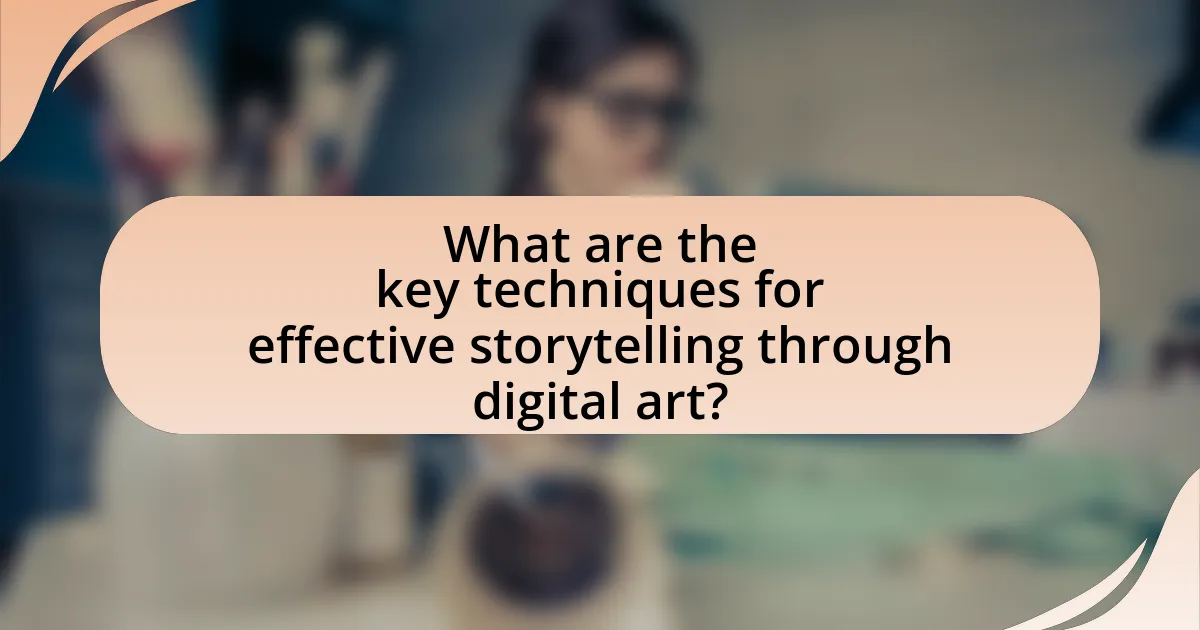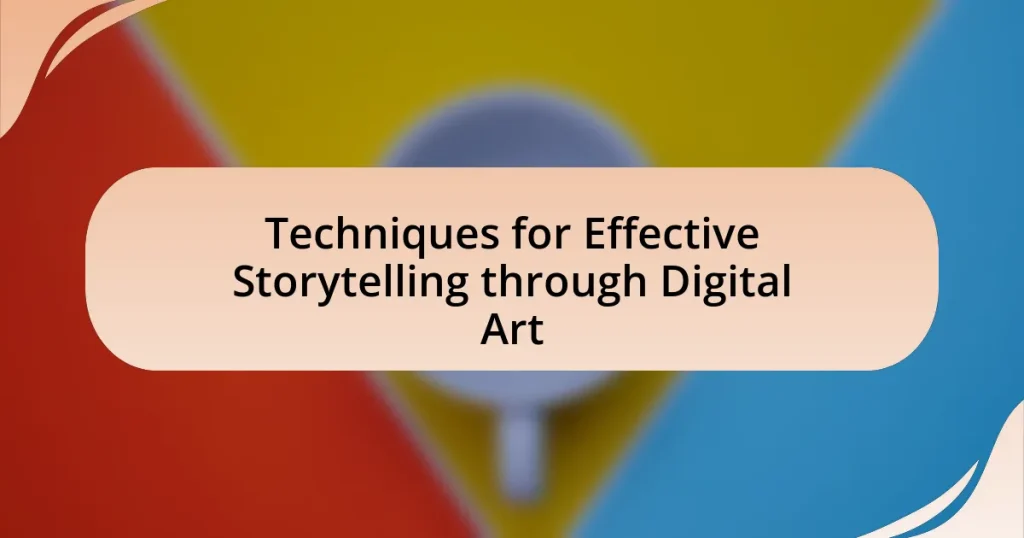The article focuses on techniques for effective storytelling through digital art, emphasizing key elements such as visual composition, color theory, character development, and narrative pacing. It explores how visual narratives enhance storytelling by creating immersive experiences that engage viewers emotionally and intellectually. Additionally, the article discusses the importance of character design, environment, and the integration of digital tools in crafting compelling narratives. It also addresses common challenges in digital storytelling and outlines best practices for creating engaging digital art stories, supported by relevant research and examples from the industry.

What are the key techniques for effective storytelling through digital art?
The key techniques for effective storytelling through digital art include visual composition, color theory, character development, and narrative pacing. Visual composition involves arranging elements to guide the viewer’s eye and create a focal point, enhancing the story’s clarity. Color theory plays a crucial role in evoking emotions and setting the mood; for instance, warm colors can convey warmth or aggression, while cool colors can suggest calmness or sadness. Character development is essential for creating relatable and dynamic figures that resonate with the audience, often achieved through expressive features and body language. Narrative pacing, which dictates the flow of the story, can be manipulated through the timing of visual elements and transitions, ensuring that the audience remains engaged. These techniques are supported by studies in visual storytelling, such as those by McCloud in “Understanding Comics,” which emphasize the importance of visual elements in narrative construction.
How does visual narrative enhance storytelling in digital art?
Visual narrative enhances storytelling in digital art by creating a cohesive and immersive experience that engages viewers emotionally and intellectually. This technique allows artists to convey complex themes and emotions through visual elements such as composition, color, and symbolism, which can evoke specific responses from the audience. For instance, a study published in the Journal of Visual Culture highlights that visual narratives can significantly increase viewer retention and understanding of the story being told, as images often communicate ideas more effectively than text alone. By integrating visual storytelling techniques, digital artists can craft compelling narratives that resonate with audiences, making the art more impactful and memorable.
What elements contribute to a compelling visual narrative?
A compelling visual narrative is primarily constructed through elements such as strong composition, color theory, character development, and emotional resonance. Strong composition guides the viewer’s eye and creates a sense of balance, while color theory evokes specific emotions and sets the mood. Character development allows audiences to connect with the story on a personal level, making the narrative more relatable. Emotional resonance engages viewers, prompting them to feel and reflect on the story being told. Research indicates that narratives with these elements are more likely to engage audiences effectively, as evidenced by studies in visual storytelling that highlight the importance of these components in creating impactful art.
How can color and composition influence the viewer’s perception?
Color and composition significantly influence the viewer’s perception by evoking emotions and guiding attention. For instance, warm colors like red and yellow can create feelings of warmth or excitement, while cool colors such as blue and green often evoke calmness or serenity. Composition, including the arrangement of elements within a piece, directs the viewer’s gaze and can emphasize certain aspects of the narrative. Research by the American Psychological Association indicates that color can affect mood and behavior, demonstrating that specific hues can elicit particular emotional responses. Additionally, the rule of thirds in composition helps create balance and focus, enhancing the storytelling aspect by leading the viewer through the artwork in a deliberate manner.
Why is character development important in digital storytelling?
Character development is crucial in digital storytelling because it fosters emotional engagement and relatability with the audience. Well-developed characters allow viewers to connect on a personal level, enhancing their investment in the narrative. Research indicates that stories with strong character arcs lead to higher audience retention and satisfaction, as seen in studies by the University of California, which found that narratives featuring complex characters resulted in a 30% increase in viewer engagement compared to those with flat characters. This connection not only drives the plot forward but also enriches the overall storytelling experience, making character development a fundamental technique in effective digital storytelling.
What techniques can be used to create relatable characters?
To create relatable characters, writers can employ techniques such as developing complex backstories, incorporating universal emotions, and showcasing flaws. Complex backstories provide depth, allowing audiences to understand characters’ motivations and experiences, which fosters empathy. Universal emotions, such as love, fear, and joy, resonate with a wide audience, making characters feel familiar and accessible. Additionally, showcasing flaws humanizes characters, as imperfections reflect real-life experiences, making them more relatable. Research indicates that characters with relatable traits enhance audience engagement and emotional investment, as seen in studies on narrative transportation and character identification.
How does character design impact the overall story?
Character design significantly impacts the overall story by shaping audience perception and emotional engagement. Well-crafted characters visually convey traits, motivations, and arcs, which enhances narrative depth. For instance, a character’s color palette can symbolize their emotional state or moral alignment, influencing how viewers interpret their actions and decisions. Research indicates that visual elements in character design can evoke specific emotional responses, thereby guiding audience reactions and investment in the storyline. This connection between design and narrative is evident in successful franchises like Pixar, where character aesthetics are meticulously aligned with their roles in the story, reinforcing themes and emotional beats.
What role does environment play in storytelling through digital art?
Environment plays a crucial role in storytelling through digital art by establishing context, mood, and narrative depth. The setting influences how viewers interpret characters and events, guiding emotional responses and engagement. For instance, a dystopian landscape can evoke feelings of despair, while a vibrant natural scene may inspire hope. Research indicates that environments can significantly affect audience perception; a study published in the Journal of Visual Culture highlights that immersive backgrounds enhance narrative comprehension and emotional resonance. Thus, the environment not only supports the storyline but also enriches the viewer’s experience, making it an essential element in digital art storytelling.
How can backgrounds and settings enhance the narrative?
Backgrounds and settings enhance the narrative by providing context, establishing mood, and influencing character development. Context is crucial as it situates the story within a specific time and place, allowing audiences to understand the circumstances surrounding the characters. For example, a dystopian setting can evoke feelings of despair and urgency, shaping how the audience perceives the characters’ actions. Additionally, the mood created by backgrounds can amplify emotional responses; a serene landscape can contrast with a character’s turmoil, highlighting internal conflict. Furthermore, settings can influence character development by reflecting their inner states or growth; a character’s journey through a dark forest may symbolize their struggle, while emerging into a bright field can signify hope and resolution. These elements collectively deepen the audience’s engagement and understanding of the narrative.
What techniques can be used to create immersive environments?
Techniques to create immersive environments include virtual reality (VR), augmented reality (AR), interactive storytelling, and environmental design. Virtual reality immerses users in a fully digital world, allowing for a sensory experience that can enhance narrative engagement. Augmented reality overlays digital elements onto the real world, creating a blend of physical and digital storytelling that captivates users. Interactive storytelling involves user choices that influence the narrative, making the experience personal and engaging. Environmental design focuses on creating detailed and believable settings that draw users into the story, enhancing emotional connection and immersion. These techniques are supported by research indicating that immersive experiences can significantly increase user engagement and emotional response, as seen in studies on VR applications in education and entertainment.
How can digital art techniques be integrated with traditional storytelling methods?
Digital art techniques can be integrated with traditional storytelling methods by utilizing visual elements to enhance narrative engagement. For instance, digital illustrations can complement text by providing visual context, making the story more immersive. Techniques such as animation can bring static illustrations to life, allowing for dynamic storytelling that captures audience attention. Additionally, interactive digital platforms enable readers to explore story elements at their own pace, fostering a deeper connection to the narrative. Research indicates that multimedia storytelling, which combines text, visuals, and audio, significantly increases retention and emotional impact, as shown in studies by the University of Southern California’s Annenberg School for Communication.
What are the common challenges faced in digital storytelling?
Common challenges faced in digital storytelling include maintaining audience engagement, managing technical limitations, and ensuring narrative coherence. Audience engagement is critical, as studies show that 55% of viewers abandon content if it fails to capture their interest within the first few seconds. Technical limitations can hinder the quality of storytelling, as creators often face constraints related to software capabilities or hardware performance. Additionally, narrative coherence is essential; fragmented or disjointed stories can confuse audiences, leading to a loss of connection with the content. These challenges highlight the complexities involved in effectively conveying stories through digital mediums.
What specific tools and software can enhance storytelling in digital art?
Specific tools and software that can enhance storytelling in digital art include Adobe Creative Suite, Procreate, and Blender. Adobe Creative Suite offers a comprehensive set of tools for graphic design, video editing, and animation, allowing artists to create visually compelling narratives. Procreate is a powerful digital painting app that provides artists with intuitive brushes and layering options, facilitating detailed storytelling through illustrations. Blender, a 3D modeling and animation software, enables creators to build immersive environments and characters, enhancing narrative depth through visual storytelling. These tools are widely used in the industry, demonstrating their effectiveness in elevating storytelling in digital art.
How do different software options cater to various storytelling techniques?
Different software options cater to various storytelling techniques by providing specialized tools and features that enhance narrative development and visual expression. For instance, software like Adobe Premiere Pro offers advanced editing capabilities that allow for dynamic pacing and transitions, essential for building tension in a story. Similarly, tools like Twine enable interactive storytelling, allowing users to create branching narratives that engage audiences in decision-making processes. Additionally, software such as Procreate supports visual storytelling through its extensive brush library and layering options, facilitating detailed illustrations that can convey emotions and themes effectively. These features demonstrate how specific software aligns with distinct storytelling techniques, enhancing the overall narrative experience.
What features should artists look for in digital art tools?
Artists should look for features such as a user-friendly interface, customizable brushes, layer management, and high-resolution output in digital art tools. A user-friendly interface enhances workflow efficiency, allowing artists to focus on creativity rather than navigation. Customizable brushes enable artists to replicate traditional media effects and develop unique styles, while effective layer management facilitates complex compositions by allowing for non-destructive editing. High-resolution output is essential for producing professional-quality artwork suitable for various formats, including print and digital displays. These features collectively support artists in creating compelling narratives through their digital art.
What are best practices for creating engaging digital art stories?
To create engaging digital art stories, artists should focus on a clear narrative structure, compelling visuals, and emotional resonance. A well-defined narrative structure guides the audience through the story, ensuring that the beginning, middle, and end are coherent and engaging. Compelling visuals, including color schemes, composition, and character design, capture attention and enhance the storytelling experience. Emotional resonance is achieved by connecting with the audience’s feelings, which can be facilitated through relatable themes and character development. Research indicates that stories with strong emotional connections are more memorable and impactful, as demonstrated by a study published in the Journal of Media Psychology, which found that emotionally charged narratives significantly increase viewer engagement and retention.


